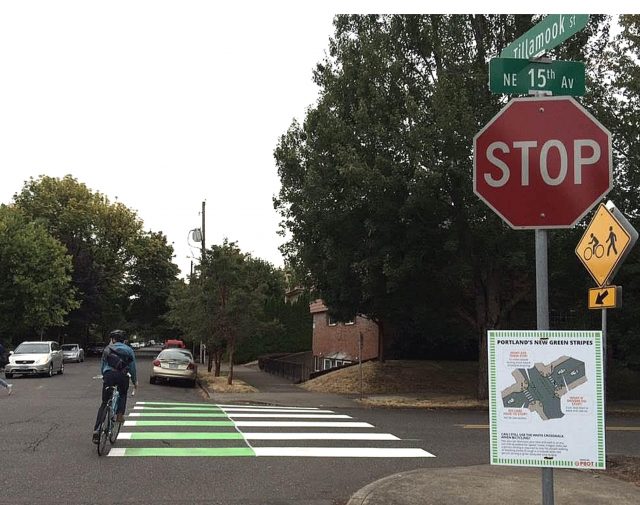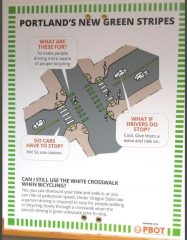
(Photo: Swanson, Thomas, Coon & Newton)
This post is part of our Get Legal series made possible by Swanson, Thomas, Coon & Newton.
When we first reported on crossbikes in August, concerns about them began almost immediately. While some people were happy to see the increased visibility for bicycling traffic at crossings via the big green stripes, others said the treatment creates confusion.
Now Ray Thomas, the Portland lawyer who literally wrote the book on Oregon bike law, is adding his voice to the chorus of concerns.
Before we get into his critique, let’s review what crossbikes are and what problem they aim to solve.
The Portland Bureau of Transportation began thinking about them five years ago after seeing how effective curb extensions were for people on foot. When a sidewalk extends out into the roadway and someone is waiting at the corner, cross-traffic tends to stop more regularly. So PBOT Bike Coordinator Roger Geller figured the same would hold true for bikeway crossings. “We we wanted to indicate that these intersections aren’t just pedestrian crossings, these are also bike crossings,” Geller told us in a 2011 interview. “The green bike bars indicate this is an extension of the bikeway through the intersection.” (Note: PBOT uses crossbikes on neighborhood greenway routes.)
Since early August PBOT has painted 21 intersections with crossbikes.

(Photo: J. Maus/BikePortland)
But here’s the rub: Traditional crosswalks have a clear legal standing. Oregon law (ORS 811.028) says you must “stop and stay stopped” if someone is attempting to walk or roll across an intersection from the sidewalk or corner. However the same legal protection is not given to someone in the roadway so cross-traffic doesn’t have any legal obligation to stop when you pull up into a crossbike.
The crossbikes have also been painted in a way that’s inconsistent: Some of the green striping is connected to an existing white crosswalk, while in other intersections (and in official PBOT educational posters) there’s a separation between the crossbike striping and the crosswalk.
With that, let’s get to Thomas’ analysis:
“In my world as a bike lawyer I get involved when things go wrong, sometimes terribly wrong. And if a bicycle rider in a crossbike moves out from the stop sign to cross the through street [and is involved in a collision]… the hard legal question must be answered of who had the right-of-way.”
— Ray Thomas
In a nutshell, Thomas feels that crossbikes add further confusion to intersections. We say “further” because Thomas has already shared his concern for what he calls “ambiguous intersections” — places where a neighborhood greenway crosses a larger street and many people (on bikes and in cars) aren’t sure if bicycle riders have the right-of-way or not.
Here’s how Thomas explains his discomfort with the way the crossbikes have been implemented. “While one might argue that to the extent it is ambiguous whether or not a motorist must stop for a cyclist in a crossbike and the motorist stops when it is not legally necessary to do so, that is OK because it promotes safe passage of vulnerable roadway users. But Geller would certainly admit that the crossbike does not somehow expand the protection of the Oregon right-of-way in the crosswalk to the crossbike crossings.”
And here’s Thomas’ underlying legal analysis:
The Oregon Traffic Code clearly requires that a bicyclist must stop at a stop sign and wait to proceed until the way is clear by yielding to cross traffic on the through street (ORS 811.260(15)). However, if the bicyclist chooses to cross the street in the crosswalk then approaching traffic is required to yield to the bicyclist because in a crosswalk, bicyclists have the same rights as pedestrians (ORS 814.410(2)). (Please note that one still cannot leave a curb or other place of safety and move out in front of approaching traffic that is so close as to constitute an immediate hazard per ORS 814.410(1)(a), I mention that in case anyone was tempted to do such a thing).
In my world as a bike lawyer I get involved when things go wrong, sometimes terribly wrong. And if a bicycle rider in a crossbike moves out from the stop sign to cross the through street because, for example, approaching traffic from one direction has stopped for them, but then another automobile coming in the other direction does not choose to stop and hits the rider, or a car behind the stopped car pulls around and then hits the cyclist, the hard legal question must be answered of who had the right-of-way. And the answer has serious legal consequences for who will have to pay for medical bills and damages. And who might get a ticket.
If the bicyclist is in the crosswalk (defined in ORS 801.220) then the driver is required to yield the right-of-way. But if the rider is not in the crosswalk then the bicyclist has violated the stop sign law in ORS 811.260(15) by failing to stay stopped for traffic on the through street.
In my view, crossbikes create the same legal problems that exist for the ambigous intersection at North Going and Martin Luther King Jr. Blvd — when everything works fine, great; but when it doesn’t the bicycle rider is likely going to be left holding the traffic citation for disregarding the legal requirements of the stop sign.
Advertisement
In an ideal world, Thomas argues, the crossbike would simply be brought into the same legal definition of a crosswalk — especially since PBOT seems to have no qualms about striping them directly adjacent (with no gap) to existing crosswalks. If the crossbike markings simply expanded the width of the crosswalk then people using bicycles in the main roadway would have the same legal protection and right-of-way as someone trying to cross from the sidewalk. That sounds great; but there’s a hitch.
Back to Thomas:

There may be a legal “color problem” at work here because just as the crosswalk’s legal definition requires only “markings or other markings” it also stipulates that it must “conform in design to the standards established for crosswalks under in ORS 810.200.” That statute says the Oregon Transportation Commission, “shall adopt a manual and specifications of uniform standards for traffic control devices…” Since the State of Oregon’s adopted manual is essentially the Manual of Uniform Traffic Control Devices and the MUTCD says crosswalks must be marked with white paint, then there may be a problem of definition.
Section 3B.18 of the MUTCD, “Crosswalk Markings” states: “When crosswalk lines are used, they shall consist of solid white lines that mark the crosswalk. They shall not be less than 6 inches or greater than 24 inches in width.”
Since Thomas is a bike safety advocate, he has also thought of a solution. Why not simply make the crossbike stripes white? “If the wider crosswalk expands to include the crossbike within it, doesn’t that just expand the coverage of the umbrella of right-of-way in a good direction?” he wonders. “If we wanted to make the crossbike into an arguable fully legal crosswalk without the legal ambiguity then we would just cover the green paint over with white and be done with it, or put some green at each end of the white paint just to denote the new design.”
In conclusion, Thomas wants to raise awareness that crossbikes — as currently implemented — are not legal crosswalks. “For now,” he says, confusion is likely to reign and, “the best course of action is to assume cars do not legally have to stop.”
We asked PBOT to respond to Thomas’ concerns. Spokesman John Brady said, “The anecdotal feedback we’ve been getting is that the crossbikes are welcomed by people on bicycles and they haven’t been causing confusion. We believe there is a growing awareness among Portlanders that green paint is associated with bicycling. That growing awareness is also something that works against confusion.” Brady was quick to add that they aren’t relying only on anecdotal evidence. Portland State University researchers are studying the new markings for before/after behaviors.
Depending on how those observations play out, we might see some tweaks to the crossbike design in the future.
— Jonathan Maus, (503) 706-8804 – jonathan@bikeportland.org
BikePortland is supported by the community (that means you!). Please become a subscriber or make a donation today.

